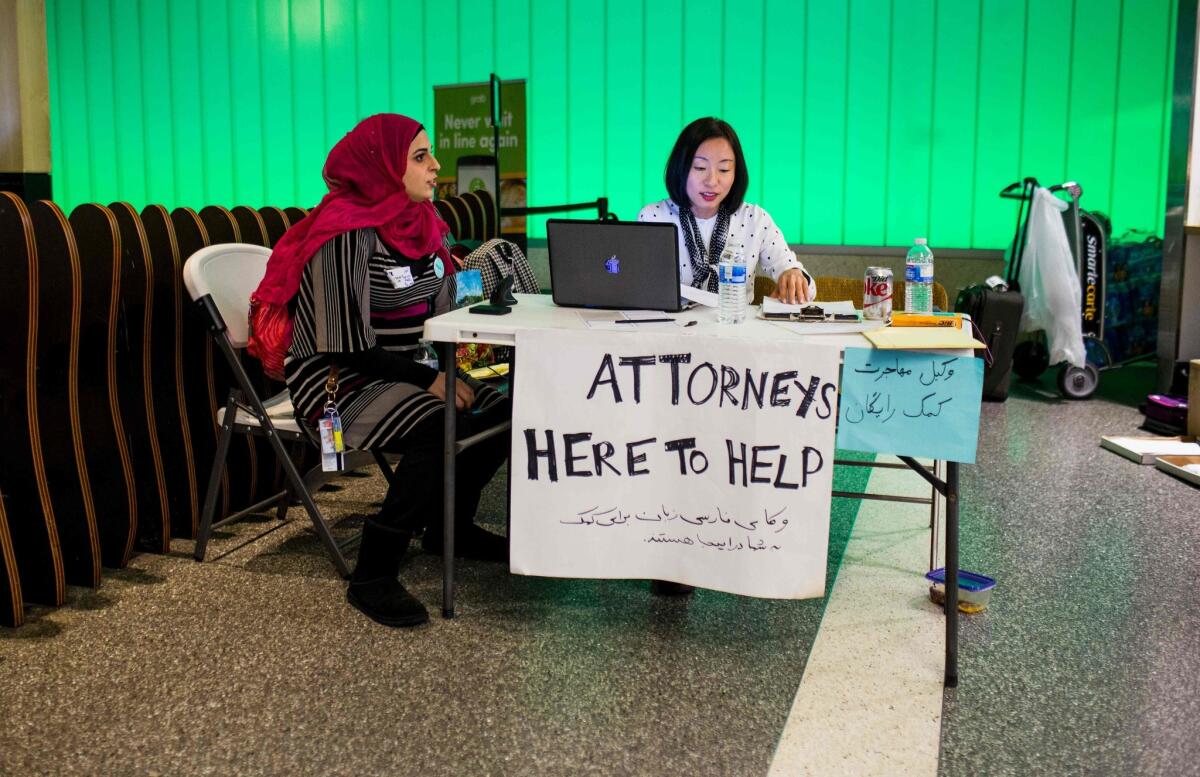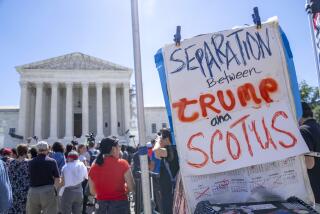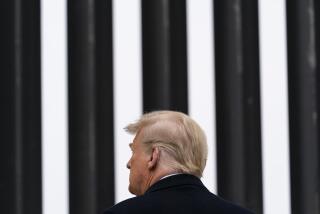Story So Far: Dozens of suits have been filed against Trump’s sweeping travel ban. Here are the most important ones

Volunteer translator Nour Our, left, and volunteer attorney Kat Choi sit in the arrivals at LAX during a protest of an executive order by President Trump.
Since President Trump signed a sweeping executive order that temporarily banned entry for refugees, as well as other immigrants from seven mostly Muslim countries, dozens of lawsuits have been filed amid widespread confusion over the new immigration rules.
On Monday, the 9th U.S. Circuit Court of Appeals in San Francisco was considering new legal briefs on both sides after initially denying a request to reinstate the travel ban, whose enforcement was temporarily blocked by a federal judge in Seattle on Friday.
Appeals court judges in San Francisco scheduled a telephone hearing on the case for Tuesday afternoon.
The circuit court set a rapid schedule for briefs on the case filed by the states of Washington and Minnesota, with major tech companies and former national security officials entering filings in support.
The White House argues that presidential power over national security and immigration puts the law on its side. The states say Trump’s order harms the economy and local residents who are from the listed countries, and also discriminates against Muslims.
The fight over whether Trump’s travel ban should be left in place as lawsuits proceed is likely to end up in the U.S. Supreme Court, as is the broader challenge to the order. In the meantime, flights carrying passengers from the banned countries and refugees were landing at U.S. international airports.
What’s at stake?
The Jan. 27 executive order included a 90-day ban on admission of nearly all citizens from Iran, Iraq, Libya, Somalia, Sudan, Syria and Yemen. It also halted all refugee admissions for 120 days, indefinitely suspended admission of Syrian refugees and said the U.S. would give preference to refugees who are members of religious minorities. Immediately after that, hundreds of refugees, green card holders and visitors with valid visas were either detained at U.S. airports, deported upon landing or not allowed to board flights to the country. The Department of Justice later told a judge that Trump’s move had resulted in 100,000 visas that were canceled around the world. The Department of State clarified the number to be less than 60,000.
Who’s fighting the president?
The Civil Rights Litigation Clearinghouse at the University of Michigan has counted dozens of lawsuits against the Trump administration in connection with the executive order. Most were filed by legal permanent residents who were detained, deported or blocked from boarding flights to the the U.S. They were filed in federal district courts in Virginia, Massachusetts, California, the District of Columbia and elsewhere. Several states have also taken the administration to court, saying the immigration order harms their economies and residents. They include Virginia, Hawaii, Massachusetts, New York, Minnesota and Washington, and they have either joined onto already existing suits or launched their own.
Who’s winning?
For the most part, it’s not Trump. But all wins have been temporary, and final results could change as lawsuits proceed.
One of the first legal wins was in a case by the American Civil Liberties Union, which requested an emergency halt to deportations of visa holders and won a stay from a federal judge in Brooklyn the night after the president’s order was signed. Another challenge was won that evening in Virginia, where a federal judge issued an order to block deportations of immigrants detained at Dulles International Airport. A Massachusetts judge followed with a similar temporary order Jan. 29. Although civil rights groups viewed many of these as applying nationally, they weren’t followed uniformly.
In Los Angeles, a major national order came Wednesday when a federal judge said that any immigrant with a valid visa had to be let into the country. The suit, still proceeding, was filed on behalf of 28 Yemenis with visas who had been unable to travel to the U.S.
But the biggest win for opponents of the order came Friday, when U.S. District Judge James L. Robart in Seattle ordered that Trump’s ban be lifted nationwide while a suit by the states of Washington and Minnesota was litigated. Notably, Robart’s action applied not only to immigrants with visas but also to refugees. He also ordered a stop to any religious preference on admissions. Robart said he thought the states had a good chance of winning the case.
In all of the above cases, judges said keeping Trump’s order intact would cause “irreparable harm,” a legal bar for immediately suspending it.
What is Trump’s case and what are the arguments against him?
The White House says the president’s order stems from his responsibility to protect national security and is based on a 65-year-old part of the of the federal Immigration and Nationality Act.
It says that “whenever the President finds that the entry of any aliens or of any class of aliens into the United States would be detrimental to the interests of the United States, he may by proclamation, and for such period as he shall deem necessary, suspend the entry of all aliens or any class of aliens as immigrants or non-immigrants, or impose on the entry of aliens any restrictions he may deem to be appropriate.”
On the other hand, another part of the act says there cannot be discrimination in regard to “the person’s race, sex, nationality, place of birth or place of residence” when it comes to “the issuance of an immigrant visa.”
The arguments against the executive order have been multi-pronged, most alleging a violation of the due process and equal protection clauses of the Constitution, as well as the Constitution’s ban on government religion. The religion argument stems from the order’s preference for admission of religious minorities, and also a TV interview Trump gave in which he said Christians would get preference. Lawyers have also cited Trump associate and former New York Mayor Rudy Giuliani, who said the order was a version of Trump’s campaign promise to ban Muslims from entering the country.
In the 9th Circuit proceedings, major officials from the Obama and George W. Bush administrations filed a declaration Sunday night saying they see Trump’s order as harmful to national security. Major tech companies, including Twitter and Google, argued in a brief that the immigration order hurts the economy because of the number of skilled immigrants those companies employ.
Who has supported the president?
One small win for the president came in Boston on Friday, when a federal judge refused to extend a temporary order blocking parts of Trump’s travel ban. The restraining order was initially put in place after the plaintiffs, who included two Iranian college professors with valid visas, were prevented from coming back to the U.S. to go to work.
“The rich immigrant history of the United States has long been a source of strength and pride in this country,” Judge Nathaniel M. Gorton wrote in his decision. “Conversely, the public interest in safety and security in this ever-more dangerous world is strong as well.”
The judge said he would not extend the order because of a Homeland Security directive that had come out ensuring that people with green cards were exempt from the new immigration rules.
The refusal from the court was largely moot because of the decision that came down in Seattle that lifted all major parts of the travel ban nationwide. But legal experts say it’s important that it’s on the record.
Many briefs in the flurry of filings to the 9th Circuit on Sunday and Monday were opposed to Trump’s travel ban. One exception was the American Center for Law and Justice, a conservative Christian activist organization, which supported the government’s argument that the president has the legal power to restrict who comes into the country.
What’s next?
The fight against the travel ban will be a long one, said Margo Schlanger, a law professor at the University of Michigan who was the head of civil rights for the Department of Homeland Security under President Obama.
Schlanger and other legal experts believe the Seattle case currently before the 9th Circuit could be the one to go to the Supreme Court because it has moved the fastest and is the most expansive.
If the Supreme Court’s ruling on the stay were to split 4 to 4, then the 9th Circuit’s decision would be kept intact.
Jaweed Kaleem is The Times’ national race and justice correspondent. Follow him on Twitter, Facebook and Instagram.
More to Read
Sign up for Essential California
The most important California stories and recommendations in your inbox every morning.
You may occasionally receive promotional content from the Los Angeles Times.











